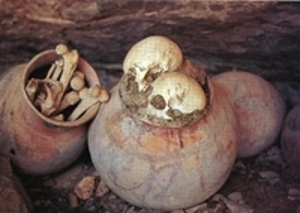Research project
Houses for the living and the dead
Organisation of settlement space and residence rules among the Taino, the indigenous people of the Caribbean encountered by Columbus
- Duration
- 2005 - 2010
- Funding
-
 NWO Open Competition
NWO Open Competition
- Partners
Museo del Hombre Dominicano
Dr. José Oliver (Institute of Archaeology-University College London)
Dr. Stéphen Rostain (CNRS; Centre National de Recherche Scientifique)
Dr. C. Lalueza-Fox (University of Barcelona)
Prof. Dr. G.R. Davis (Free University Amstedam)

Short Abstract
In this project, archaeological, archaeometric and ethnohistorical research is combined to study the organisation of settlement space and residence rules among the Taíno Indians during the Late Ceramic Age (AD 1000-1492). Research will primarily take place in the Eastern Dominican Republic, the Altagracia province. This project can be further divided into subprojects:
- The Taino of Higüey: An ethnohistorical perspective (subproject 1)
- Reading the features: A (re)construction of Taíno house structures at El Cabo in the eastern Dominican Republic (subproject 2)
- Life conditions, burial ritual, marriages, and mobility (subproject 3)
- Comparative study and synthesis (subproject 4)
Research question
To what extent is the image of the Taino settlements on Hispaniola representative for the whole island, or is it only related to a few large settlements of known caciques?
Sub-questions
- How does this data relate to archaeological data retrieved from excavations outside of Hispaniola?
- Can the functional elements, e.g. households, of a settlement be distinguished?
- Can the social status of such a household be determined and are the different statuses (common man to elite) present in one settlement?
- What do these sources tell us about the social organisation and daily activities of the residents?
- What is the spatial organisation of a settlement and how are the public areas (such as, plazas, ball-court, cemetery) distributed?
- How are these public areas related to residential structures and what do such relations tell us about the social organisation?
- How do these patterns relate to those documented for settlements such as Anse à la Gourde and Kelbey’s Ridge on the Lesser Antilles? Do they show similarities or differences in complexity of a settlement organisation?
Project Description
The Taino were the first indigenous people encountered in the New World by Christopher Columbus. Hispaniola (modern day Haiti and the Dominican Republic) was home to the most densely populated and complex precolumbian societies in the Caribbean. Existing interpretive models of village settlement and household organisation are based almost entirely on colonial documents and chronicles written by the Spanish. Such ethnohistoric models have only been minimally supplemented by archaeological data from Cuba, Puerto Rico and the Lesser Antillean islands. The main research question posed in this project focusses on the nature and representativeness of the ethnohistorical descriptions and their relation with archaeology. To what extent is the image of the Taino settlements on Hispaniola representative for the whole island, or is it only related to a few large settlements of known caciques?
The main objectives of this program is to evaluate and complement the available ethnohistorical information gathered by Columbus and others in the early colonial time period; the study of settlement organisation and the role of households in these settlements in the Late Ceramic Period through archaeological research on the site of El Cabo in the Dominican Republic, and comparing the results with simultaneous settlements in the Lesser Antilles.
This programme combines archaeological, archaeometric and ethnohistorical research to study the organisation of settlement space and residence rules among the Taíno Indians during the Late Ceramic Age (AD 1000-1492). Archaeological investigations are planned at El Cabo in the Higüey region, Altagracia province of the eastern Dominican Republic, because it provides an excellent opportunity to study the spatial organisation of a Taíno settlement in the Greater Antilles. The resulting scheme of settlement organisation is subsequently contrasted with the available data from contemporary sites on other Caribbean islands. Stable isotope and DNA analyses, palaeopathology and the study of mortuary ritual are applied to human skeletal remains to target issues such as mobility, marital and residence rules, as well as descent among the prehistoric villagers. The archaeological data will be employed to evaluate existing interpretative models of Taíno village settlements and households organisation within the chiefdom polities, or so-called cacicazgos, in Hispaniola (present day Dominican Republic and Haiti), that are currently based largely on ethnohistoric texts and archival documents written by the Spanish during the early colonial period.
Relations with other projects
European project “Life and death in a Taino community. The interplay of quotidian and ritual behaviours in the pre-Columbian Dominican Republic”, which is being executed by an international team of researchers from the Faculty of Archaeology at Leiden University, the Institute of Archaeology at the University College London, CNRS/UMR at Universtité de Paris X-Nanterre, Mueso del Hombre Dominicano, Universidad Autónoma de Santo Domingo, and the Fundación García Arévalo.
NWO-ASPASIA “Socio-political complexity in the pre-Columbian Caribbean”
VIDI-project and “Mobility and Exchange”
